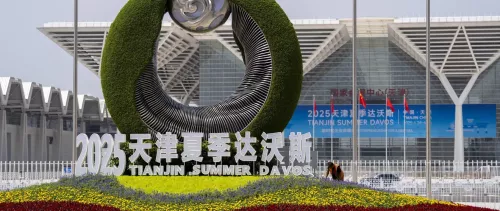
We are currently past the point of no return in a second wave of technological transformation. | Image: Unsplash: Trent Pickering
- Digital technologies will offer benefits to billions, but getting the right investment into technology is essential.
- The pandemic resulted in years of unplanned reinvention; we now need to make intentional change.
- There are more technologies available than there is money to fund them, so the strategic development of technology is key.
We are living through the most rapid period of intense technological innovation in human history, which in turn is providing us with the tools to help business and government navigate the uncertain times ahead. Digital technologies enable efficiency, helping heavy industries reduce emissions by up to 20% of their net-zero goals. The same technologies will ultimately provide billions of people with access to health, education or financial services for the first time. In another incarnation, these technologies can help SMEs connect with markets worldwide, unleashing entrepreneurialism anywhere that someone can use a smartphone. But in the face of economic headwinds, how do we ensure that we are making the right private and public investment in technology itself?
In an era where cheap credit has dried up, budgets and economies are being squeezed, and there are competing priorities for capital allocation, what strategies and decisions do government and business need to make during 2023 to ensure their digital transformation stays on track? In the decade ahead, having a clear and informed technology investment strategy will be paramount to its success.
Waves of technological transformation
Technology transformation is well under way. Anyone reading this has probably experienced the first wave – enabled by computers in our pockets – characterized by a complete reimagination of how we shop, learn, entertain ourselves, travel and even find our way around the world.
Accelerated by the pandemic, we are currently ‘past the point of no return’ on a major second wave – enabled by ubiquitous, connected and intelligent things – which is transforming the world of business. Not only how we work, but technologies like 5G, AI and ‘as-a-service’ business models are driving a reimagination of manufacturing, supply chains, urban infrastructure, energy and mobility. Global spend on ICT technologies in 2022 is expected to be $5.82 trillion, exceeding 5% of global GDP for the first time. In addition to growth, this is starting to drive greater efficiency, supply chain transparency, emission reductions and circular business models. It will likely take several years to fully realize these opportunities and innovations.
We can also see a third wave of technologies emerging. Quantum technologies and biotech hold the potential to usher in a new age of scientific discovery in both life and non-life materials, transforming our societies. No country can be a leader in all technologies, so governments are already making decisions on where they want to focus their energies. Clarity on these future roadmaps is crucial for industry leaders looking to make decisions on where they make large-scale investments.
In 2023, we stand at a crossroads. The pandemic resulted in years of unplanned reinvention, which built on a decade of consumer-facing innovation supported by cheap credit, stability and growth. We now need to make intentional change. There are more opportunities and technologies available than can be invested in. This makes the strategic development of technology hugely important, meaning that the financing decisions that government and business take in the coming 12 to 24 months will shape their prospects for the rest of the decade.
Challenges and opportunities
There is no blueprint for the technology transition. As a result, there are inconsistencies in how different sectors are approaching this type of investment. This has culminated in an overall failure to effectively articulate how transformation affects strategy and long-term progress. Reflecting this, Deloitte has reported that 85% of CEOs who accelerated digital initiatives during the pandemic have subsequently struggled to translate this into strategy.
Perhaps unsurprisingly, therefore, digital leaders in businesses often face difficulty in obtaining the funds they need for investment because organizationally technology transformation differs from standard IT investment. There are few fixed projects, standard metrics aren’t always applicable, and different skill sets, processes and departments are often needed to fulfil a project. Furthermore, programmes don’t always meet expectations, one survey putting this number at 87%.
From a societal perspective, estimates for how much it would cost to ensure every individual has the opportunity to use the internet range from $700 billion to $2 trillion. As the situation stands, 95% of the world’s population lives within range of broadband infrastructure, yet 2.7 billion people remain offline.
While there is an intuitive understanding of the enabling capabilities of digital technologies, financing is often stymied by narrow thinking around ICT as a vertical (rather than a horizontal enabler) and as a boon to fiscal coffers.
Critically, we lack a framework to think about enabling the transition in a strategic and holistic way. Strategic in the sense that companies or governments can be confident when making decisions on not only what to invest in, but what not to invest in. And holistic in the sense that we account for all the elements of enabling a digital society, and we know how to align the right types of capital and incentives with the right investments.
Positive shifts are under way. One big change that is materializing is the understanding that the technology transformation will ultimately matter to everyone. Although digital infrastructure doesn’t yet feature as a priority in investment strategy, investment into it is increasing, with 2021 a record-breaking year. More than one-half of all infrastructure funds raised had a digital focus, with more than $64 billion generated. Supply chain and production challenges for critical semiconductor technology components resulted in more than $200 billion of capacity investments from countries and companies, particularly in US and Europe, while global investments in quantum technologies reached $35.5 billion globally.
Thinking strategically and long term
he global automative sector has become one of the largest investors in digital transformation, with the electrification of the sector the most obviously recognizable example of this. Here, ABB’s experiences highlight the benefits of thinking strategically. In 2021, it announced plans to make its e-mobility business a separate entity, using the capital raised to support acquisitions and investment. It focused the latter on partnerships in developing battery or charging technology, and has a long-term goal of moving beyond charging hardware into software and services to expand its overall market. This is reflective of broader industry innovation and adoption of technologies in ways that deliver both for the bottom line and their societal responsibilities.
Thinking about the digital infrastructure needed to support the intelligence and inclusive digital economies of the future requires an holistic approach from both boardrooms and government high office. From communications and computing infrastructure to components, security needs, and empowering a digital-ready workforce and entrepreneurial ecosystem, preparing for our digital future is a team sport.
We need to understand that technological improvements and transformation – of the type witnessed during the pandemic – are not side-effects but are rapidly becoming driving forces of the market. But without having a strategy for investment, technological transformation will fail to develop as swiftly and robustly as it would otherwise have done.
This article was originally published in Sina.


